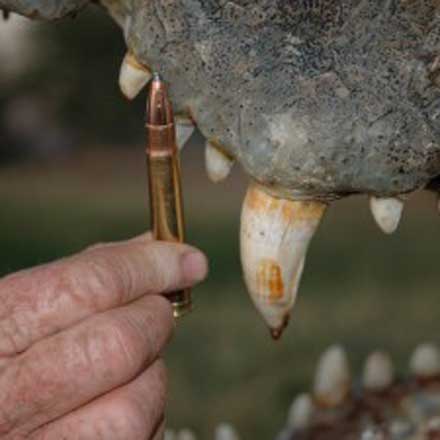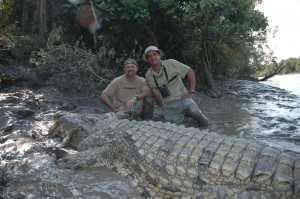
“Nile crocodile” makes a nice rhyme, but is actually a misnomer. Well, not exactly. There are Nile crocodiles in the Nile River, but there are also Nile crocodiles in the many hundreds of rivers, swamps, lakes and mudholes between Egypt and South Africa. Off to the west, there is another, much smaller crocodile, but throughout most of Africa, the big, green lizard is the Nile crocodile. And yes, he gets very big. Rumors abound of 20-foot crocs, which may, or may not exist—but they definitely reach into the upper teens in length.
A crocodile like that would weigh well over a ton, and since reptiles grow throughout their lives, would be at least 60 over 70 years old, perhaps a full century. It doesn’t take a croc that big or that old to be dangerous. In fact, all crocodiles are potential maneaters, and I’d guess most that reach their middle years have tasted human flesh. Any animal that comes to drink in the crocodile’s sanctuary is fair game, and the majority of rural Africans get their water from natural sources. The crocodile is just one of the dangers they face as part of their lives.
Me, I’ve always been extremely careful when I’m near water that might hold crocs—and it doesn’t take much water! In the African winter, when most hunting is done, crocodiles will typically “haul out” and sun on beaches and mudbars during the heat of the day, and that’s when you see them. The crocodile you can see is no danger at all. Late in the day, when the air temperature drops, and the water is actually warmer, the crocodiles take to the water…and then you don’t see them anymore. They do most of their hunting from late afternoon until early morning, but it can happen at any time. Their charge out of the water is incredibly fast; the power of their jaws inescapable; the horror of the death they bring unimaginable.
For most of my hunting career, I have accepted crocodiles as part of the African scenery. I’ve seen them along the banks, and I’ve been very careful along those same banks. I’ve stood crocodile guard while fishing and recovering hippos, and I’ll admit, that once when I was a whole lot younger and even more foolish, I waded a crocodile-infested river to recover a bushbuck (not worth the risk!). Crocodiles were just part of the scenery, something to consciously avoid. Of course they were hunted, in some
places relentlessly, for their skins. But only recently have crocodiles been accepted as a...
serious hunting trophy.
This new trophy status is very much a “win-win” situation. It’s a big win for the crocodiles because with added value as a trophy comes protection. Hunting wild crocodiles for skins is long since over. Belts, purses, and cowboy boots now come from crocodile farms, and, in hunting areas, quotas are limited. But we hunters are, perhaps, the bigger winners because a crocodile hunt is one of the most interesting of all the adventures a safari can bring.

The thing is, you have to take the crocodile on dry ground—which is not his natural habitat. So you must stalk him while he’s basking, or you must bait him onto the beach. The reason this is necessary is that if you take him in water, he will sink, and even if you make a perfect shot, you will lose him. This business of taking him on land is not so easy. Few animals are as wary, or as aware, as a crocodile. Especially a big crocodile who has seen it all and probably done it all for three-fourths of a century or more. You do not simply walk up on a basking crocodile!
Then, there’s the shooting challenge. It isn’t enough to kill a crocodile. You must anchor him on the spot. Otherwise, with one powerful sweep of his tail, he will get into the water, which is what we call “an expensive splash.” Whether mortally hit or not, once in the water, he’s gone. The only two options are the walnut-sized brain or the grapefruit-size area where head and spine connect. The brain is located just slightly below and behind the bony ears, a small target, but reachable from almost any angle. The spine shot is sensibly taken only from a broadside presentation. The proper hold is about six inches behind the end of his smile. Neither shot offers room for error, and both are among the most difficult in the world of hunting.
As I said, only fairly recently has the crocodile been considered a hunting trophy, and I had never given much thought to taking one. The first time I ever even saw a crocodile taken was in Tanzania in 2000. Hunting partner Art Wheaton wanted one, so we stalked a bit croc on his lying-up spot for several days. After the first couple of tries, I realized it wasn’t quite as easy as it sounded....
When he finally got his shot, it was from one side of the Little Ruaha River to the other, maybe 150 yards. I was sort of glad I didn’t have to make the shot! Art anchored him cleanly, and I was pretty impressed by the whole process.
My two partners in our African filming, Tim Danklef and Dave Fulson, both have much more experience with crocodile hunting than I, and they love it. A few years later, after we finished a leopard film, we had some time and our outfitter, Chifuti Safaris, had a crocodile available on quota. They talked me into it, and we went crocodile hunting on the Lower Zambezi.
We got lucky, and the hunt didn’t take all that long, but it was the most difficult and painstaking stalk I have ever made. I cannot recall a more difficult shot. The distance was maybe 80 yards, maybe a bit less, but I was using my .375 with a low-powered scope, and the crosshairs covered everything I needed to shoot at. I finally thought I had it figured, and let ‘er rip. Fortunately, I guessed correctly; the croc thrashed a bit and was still.

Another thing I have learned is that crocodiles are among the most difficult creatures in nature to judge. A shootable croc is perhaps 12 feet. A big one is 13 feet. A monster is 14 feet, and anything bigger is a crocosaurus! But where is theyardstick? In a group, a big crocodile willstand out. Big jowls and obvious girth are telltale signs, and an old bull crocodile tends to be almost black rather than green. But how do you really tell? No PHwill get this one right all the time.
I was with Andrew Dawson when we took my croc, and he’s a very good, very capable, and very cautious PH. We had watched this croc for quite a while as we maneuvered for a shot, and he thought he knew him from previous sightings. But how big was he really? Unknown! We took the shot from one peninsula to another, so to reach the animal, we had to get the boat and go around. So as we rounded the point and saw my crocodile lying still, I did the worst thing I have ever done to anyone I’ve hunted with. I blurted what came into my mind, which was, “Gee, he doesn’t look very big.”
I’ve been in some tight spots with Andrew Dawson, but...
I’ve never seen such a look of panic on his face. I don’t remember what he said, but I know it was noncommittal because crocodile hunting being as it is, he wasn’t sure either! But he had it right, and this time the closer we got, the bigger the thing looked. He was fifteen feet, four inches, an awful lot of lizard, and a great hunt, as well as a great trophy.